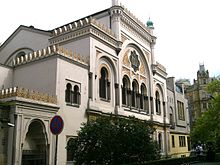Spanish Synagogue (Prague)
| Spanish Synagogue Španělská synagoga |
|
|---|---|
 |
|
| Basic information | |
| Location | Prague, Czech Republic |
| Geographic coordinates | 50°05′25″N 14°25′15″E / 50.090278°N 14.420833°ECoordinates: 50°05′25″N 14°25′15″E / 50.090278°N 14.420833°E |
| Affiliation | Conservative Judaism |
| Status | Museum |
| Architectural description | |
| Architect(s) | Josef Niklas, Vojtěch Ignác Ullmann |
| Architectural style | Moorish Revival Architecture |
| Completed | 1868 |
The Spanish Synagogue (Hebrew: בית הכנסת הספרדי, Czech: Španělská synagoga, German: Spanische Synagoge) is the newest synagogue in the area of the so-called Jewish Town, yet paradoxically, it was built at the place of the presumably oldest synagogue, Old School (also known as Altshul). The synagogue is built in Moorish Revival Style. Only a little park with a modern statue of famous Prague writer Franz Kafka (by Jaroslav Róna) lies between it and the church of St Spirit. Today, the Spanish Synagogue is administered by the Jewish Museum in Prague.
The Spanish Synagogue is not the first synagogue at the site. Before it there stood probably the oldest synagogue in Prague, Old School. In the second half of 19th century, capacity of the Old School did not suffice. The Reform Jewish Community, which used it by the time, therefore decided to demolish the synagogue in 1867 and one year later it was replaced by the new, Spanish Synagogue. Its name presumably refers to the style in which it was built, Moorish Revival style, which was inspired by the art of Arabic period of Spanish history (this name was not always prevalent, in the beginnings it was usually called by German-speaking Jews Geistgasse-Tempel, i. e. Temple in Spirit Street). The architectural plans were designed by Vojtěch Ignác Ullmann and Josef Niklas (an imposing interior decoration).
In 1935, a functionalistic building, designed by Karel Pecánek, was added to the synagogue. Till the Second World War it served to the Jewish Community as a hospital. The synagogue used the space of the new building as well; there was a vestibule and a winter oratory in it. Since 1935, the appearance of the synagogue remained essentially unchanged.
...
Wikipedia
